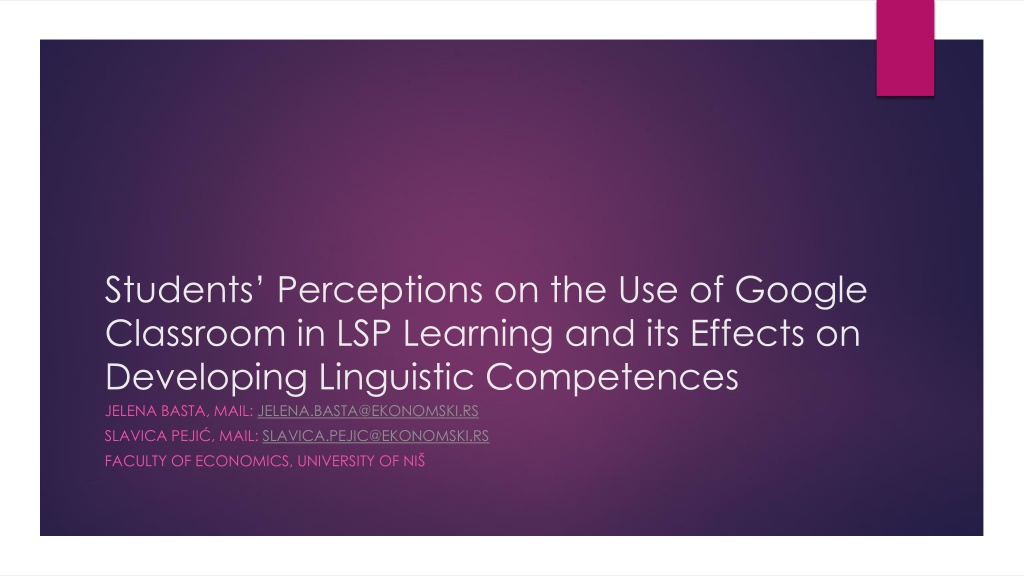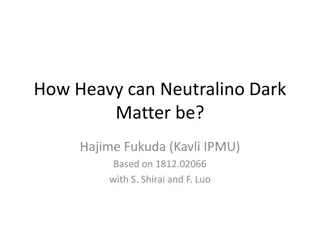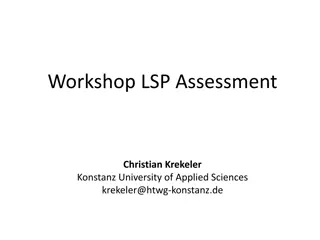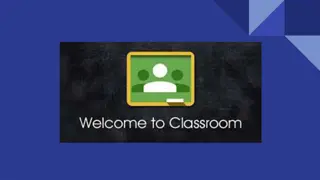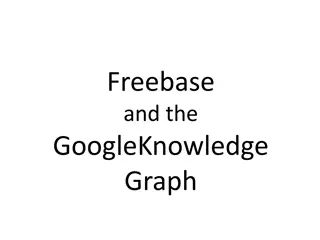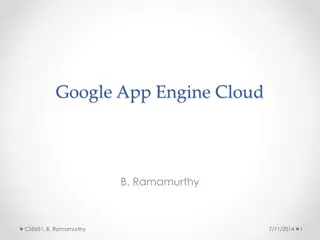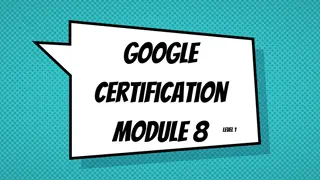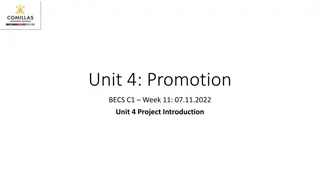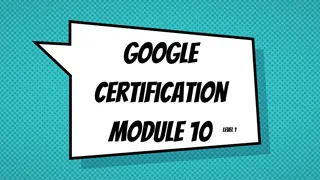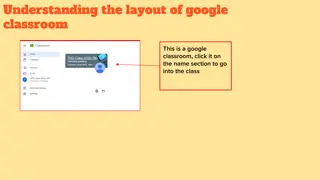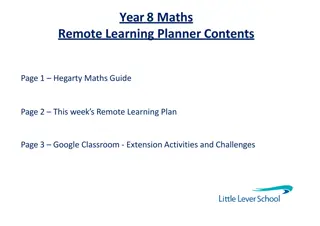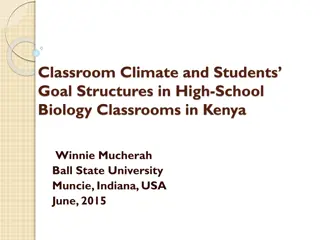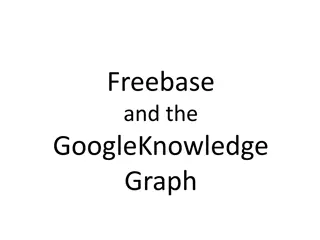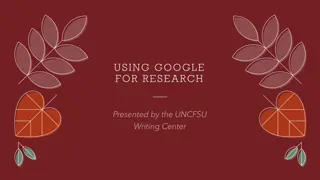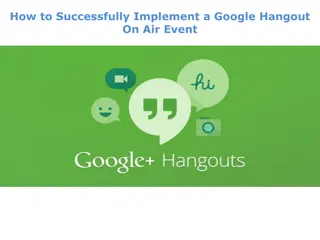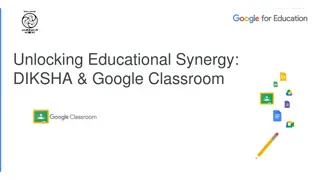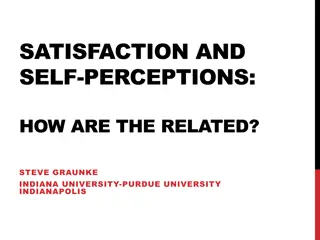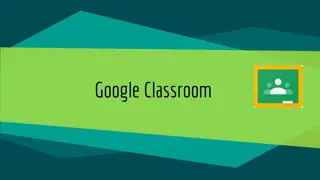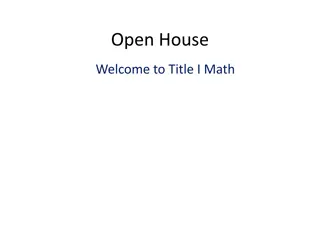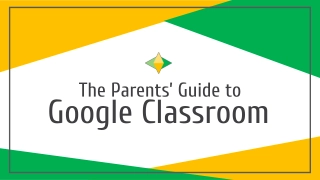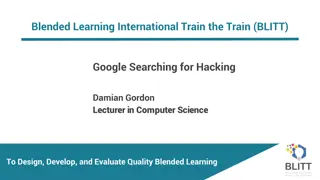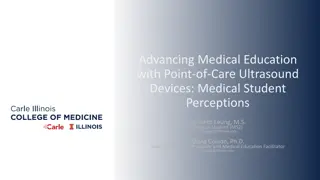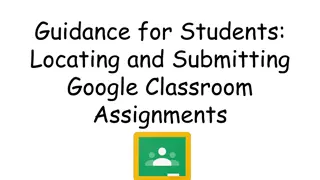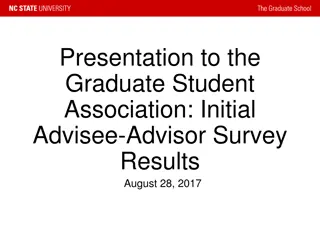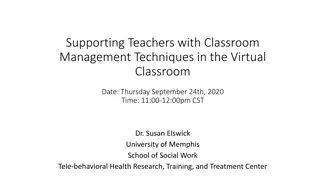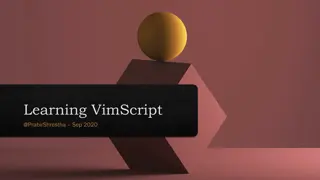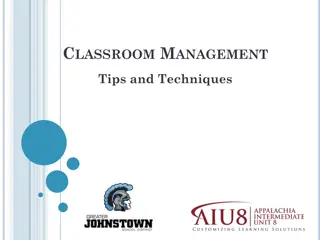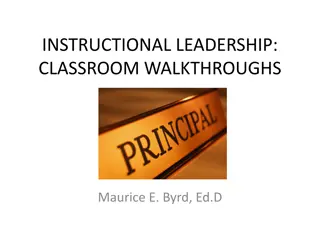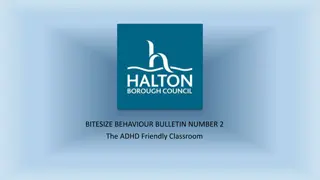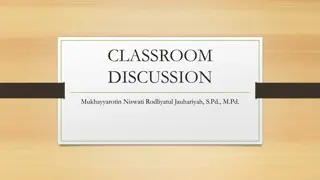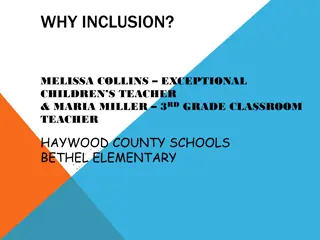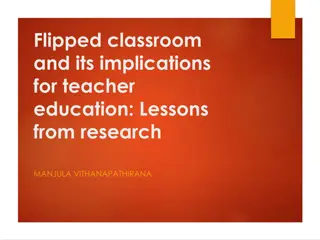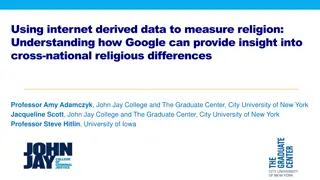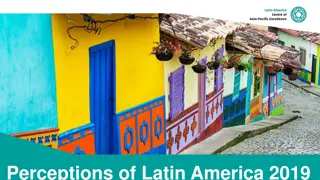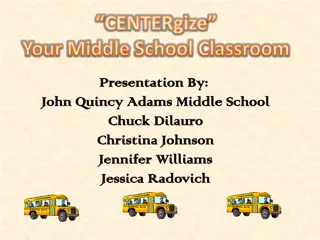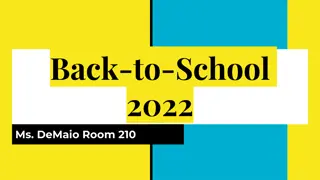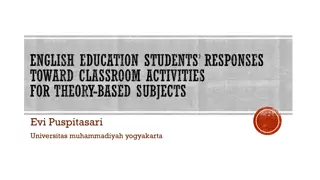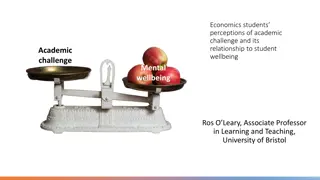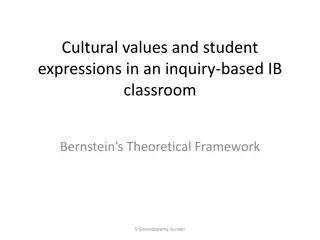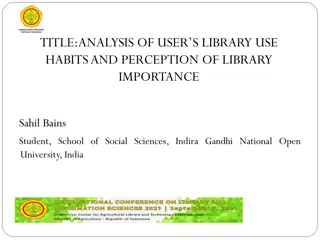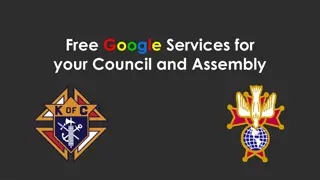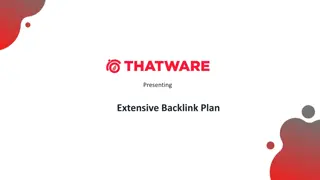Exploring Students' Perceptions of Google Classroom in LSP Learning
The study delves into how students at the Faculty of Economics, University of Ni perceive Google Classroom for LSP learning, examining ease of use, usefulness, and impact on linguistic competences. Google Classroom's features, benefits, and challenges in enhancing digital learning are discussed within a theoretical framework, emphasizing its role in modern education amid a shift towards online platforms due to the COVID-19 pandemic.
Download Presentation

Please find below an Image/Link to download the presentation.
The content on the website is provided AS IS for your information and personal use only. It may not be sold, licensed, or shared on other websites without obtaining consent from the author. Download presentation by click this link. If you encounter any issues during the download, it is possible that the publisher has removed the file from their server.
E N D
Presentation Transcript
Students Perceptions on the Use of Google Classroom in LSP Learning and its Effects on Developing Linguistic Competences JELENA BASTA, MAIL: JELENA.BASTA@EKONOMSKI.RS SLAVICA PEJI , MAIL: SLAVICA.PEJIC@EKONOMSKI.RS FACULTY OF ECONOMICS, UNIVERSITY OF NI
Introduction A new, modern, globalized world digitalized technologies. The use of information and communication technologies in all spheres of life, including the educational system, and teaching/learning processes. The pandemic of COVID-19 and the lockdown of all educational institutions traditional teaching/learning methods put aside online learning was brought to the foreground all educational levels, all types of classrooms, including LSP. Higher education students more frequently refer to new technologies an opportunity for web designers to develop new teaching/learning platforms. Students perceive new technologies as positive and desirable (Al Bataineh et al., 2019), but changes in students lives seem frightening. Not so much time for new technologies students more involved in thinking about time limitations than in actual educational opportunities (Staford, 2011).
Introduction Teaching/learning platforms spare time, teach social skills, encourage autonomous and independent learning, keep pace with new technologies, improve learning outcomes and results (Taylor et al., 2011; Kuh & Hu, 2001) students active participants. Online learning educational experiences in a synchronous and asynchronous environment with the use of various devices (Singh and Thurman, 2019) applications, platforms, quizzes no time limits to access the materials. The aim of the paper the perceptions of the LSP students of the Faculty of Economics, University of Ni about the use of Google Classroom (GC). Three questions: 1. Do LSP students believe that GC is easy to use? 2. Do LSP students believe that GC is useful for LSP learning? 3. Do LSP students believe that the use of GC positively affects the development of linguistic competences writing, reading, listening and speaking?
Theoretical framework GC released on 12 August 2014 a free platform students and teachers connect both inside and outside the real classroom more than 30 million assignments were submitted in the first six months. GC a newly-accepted, innovative platform for teaching/learning aimed at improving the process of digital learning it integrates technology into a traditional learning setting it complements traditional classes. GC part of the package Google Apps for Education(Northey et al., 2015) easy to use (Janzen, 2014) a simple organization time saving easy to access paperless (Hulse, 2019) teachers are flexible about setting class times GC eliminates travel costs. GC automatically creates a folder on the Google drive for each assignment both students and teachers can follow the progress and share comments. Teachers can directly invite students to GC or they can share a code GC organization takes only a few minutes paper-, money- and time-saving no additional storage required everything is at one place.
Theoretical framework Teachers can make announcements in the real time and interact with students the stream of the platform used for additional announcements, students questions, and further interaction no advertisements. Conflicting opinions about GC some believe that the contribution of GC is immense (Northey et al. 2015) , while some prefer traditional teaching methods (Pienta, 2016; Henrie, Halverson, & Graham, 2015). Blended learning a solution. Although digital teaching materials encourage students to actively participate, various tools available to students which facilitate doing the assignments they reduce the positive effects of learning. Various challenges when using GC students privacy, differences between learning/teaching aims and outcomes of students and institutions.
Theoretical framework Challenges for LSP teachers can LSP teachers cover all four linguistic competences when they use GC and can students successfully develop these competences? The focus of LSP functional literacy vocabulary and grammar within the professional context and development of writing and speaking skills materials should be adapted to such a context ready-made materials for LSP rarely available. So far several studies on the perceptions of students about the use of GC easy to access and easy to use (Al-Maroof and Al-Emran, 2018). Non-linear relationship between motivation and habit (Kumar and Bervell, 2019).
Methodology The research examines the opinions of students about the ease of use and usefulness of GC, and its effects on the development of four linguistic competences. The data were obtained from two sources (a) a five-point Likert scale (1) strongly disagree, (2) disagree, (3) neutral, (4) agree, (5) strongly agree and (b) one open-ended question. To identify the verbal interpretation of the range of the mean score, S zen and G ven s interval (Table 1) of 5-point scale (S zen and G ven, 2019) was used. Mean 1 to 1,80 1,81 to 2,60 2,61 to 3,40 3,41 to 4,20 4,21 to 5,00 Interpretation strongly disagree disagree neutral agree strongly agree Table 1: The verbal interpretation of mean values obtained by the questionnaire.
Methodology Interviewees and the research context: the schoolyear 2019-20 the lockdown 100 LSP students aged between 20 and 22. Types of in-class teaching materials and GC materials. GC materials PPT presentations and YouTube videos. Homework assignments in GC covering all four linguistic competences. Data collection two segments of the questionnaire: 1. Data about the ease of use and usefulness of GC; 2. Data about the effects of GC on LSP students linguistic competences.
Results and discussion Do LSP students believe GC is easy to use? (Table 2) 1. Statement Mean 4.80 Interpretation strongly agree GC is easy to sign in. Learning materials are easy to access. 4.36 strongly agree Assignments are easy to receive. 4.72 strongly agree Assignments are easy to submit. 3.93 agree GC is easy to use. 4.19 agree It is easy to understand the GC system. 4.37 strongly agree Mean of all statements. 4.395 strongly agree Table 2: Attitudes of LSP students about the ease of use of GC
Results and discussion Absolutely positive attitudes about the ease of use of GC. One click to enter the classroom. Teaching/learning materials visually distinguishable a special symbol used for them, divided into different sections, no waste of time. Assignments easy to get the students get a notification for each new assignment. GC is easy to use and students understand the way GC functions transparent and simple. Lowest score assignments are easy to submit no access to the Internet all the times; students do not understand the preconditions necessary for submitting the assignments.
Results and discussion Do LSP students believe that GC is useful for LSP learning? Statement 2. Mean Interpretation GC activities are useful. GC represents an excellent means of social interaction. 3.67 3.29 agree neutral GC enables more regular and timely assignment submission. 4.48 strongly agree The teacher gives useful feedback on submitted assignments in GC. 4.16 agree GC provides a useful grading and follow-up system. GC provides a clear subject description. 3.90 4.11 agree agree GC should be used in higher education. 4.36 strongly agree Mean of all statements 4.00 agree Table 3. Students attitudes about the usefulness of GC
Results and discussion A very useful teaching/learning tool activities are useful although GC cannot substitute the real classroom. Is it an excellent means of social interaction?- not so much the teacher get no notifications about the posted questions on the stream. GC tries to interconnect the social and academic discourse but other social networks used. Regular assignment submission students dedicated to doing the assignments work till late at night. Dedication to assignments crucial the students do not get distracted by unproductive activities (Mercer & D rnyei, 2020). The teacher grades the assignments the students can see their scores and personal comments an excellent source of feedback. No problems understanding the subject description GC should be also used for other academic subjects.
Results and discussion Drawbacks of GC revealed by answers to the open-ended question. No internet access all the time. Some students were frustrated because of other various distractions online unable to make use of all the benefits of GC. Yet, most students capable of resisting the challenges outside GC.
Results and discussion 3. Do LSP students believe that the use of GC positively affects the development of linguistic competences writing? Statement I more willingly do my writing assignments in GC than in the real classroom. I pay more attention to the word order when I do my writing assignment in GC than in the real classroom. I pay more attention to the vocabulary I use when I do my writing assignment in GC than in the real classroom. I pay more attention to the discourse management when I do my writing assignment in GC than in the real classroom. I pay more attention to the use of formal vocabulary when I do my writing assignment in GC than in the real classroom. I pay more attention to spelling when I do my writing assignment in GC than in the real classroom. GC positively affected my writing competence. Mean of all statements Mean 4.36 Interpretation strongly agree 3.95 agree 4.29 strongly agree 3.62 agree 4.60 strongly agree 4.56 strongly agree 4.63 4.24 strongly agree strongly agree Table 4. Students' attitudes about the effects of GC on the writing competence
Results and discussion Very little research on the effects of GC on the development of LSP linguistic competences. GC can be accessed from various devices the active engagement of the students at any place and time. Paperless makes the process of writing, as well as grading simpler. Various computer tools available to the students which make writing easier. Doing the writing assignment not only putting forward ideas, but also creating a comprehensible text (Tangermpoon, 2008) the good knowledge of lexical items and discourse management. Various programmes for writing enhance the writing competence spelling checkers, synonyms, grammar mistakes yet, no discourse management solutions. A more careful selection of the register more time to pay attention to all linguistic segments the internet also helps check the register. Greater motivation the students become active participants in the educational process (Bozdogan, 2012) they learn from their own mistakes. A positive effect on the writing competence.
Results and discussion Do LSP students believe that the use of GC positively affects the development of linguistic competences reading? Statement 3. Mean Interpretation I more willingly do my reading assignments in GC than in the real classroom. I pay more attention to the new vocabulary I come across in the text when I do my reading assignment in GC than in the real classroom. I pay more attention to the sentence structure when I do my reading assignment in GC than in the real classroom. I am more focused when I do my reading assignment in GC than in the real classroom. I can better understand the text when I do my reading assignment in GC than in the real classroom. GC positively affected my reading competence. 4.37 strongly agree 4.66 strongly agree 3.25 neutral 4.38 strongly agree 4.79 strongly agree 4.72 strongly agree Mean of all statements 4.36 strongly agree Table 4. Students' attitudes about the effects of GC on the reading competence
Results and discussion GC very useful for the development of the reading competence depends exclusively on self- commitment and motivation the teacher s task to boost the students confidence (Ali et al., 2021). The students more motivated to do the reading assignments more time to carefully read the text, look for the unknown vocabulary, and analyse the sentence structure. GC facilitates the interaction between the students and the text adjusted to various learning styles (Bensalem, 2018) a friendly environment an individualised approach to the text in line with the students competences and needs (Hassan Taj, 2017). No time pressure easier to focus on the text. No early classes the students pick the time when to study. GC positively affects the reading competence increases motivation. Digital technologies provide a sense of security this leads to the increase in self-confidence, self- control and responsibility for one s own learning.
Results and discussion 3. Do LSP students believe that the use of GC positively affects the development of linguistic competences listening? Statement Mean Interpretation I pay more attention to the explanations presented in videos posted in GC than to the ones presented by the teacher in the real classroom. I better understand the contents of the videos presented in GC than the very teacher in the real classroom. GC positively affected my listening competence. 4.62 strongly agree 3.78 agree 4.22 strongly agree Mean of all statements 4.21 strongly agree Table 4. Students' attitudes about the effects of GC on the listening competence
Results and discussion Listening an ability to correctly interpret and understand messages in the communication process. Students with prominent comprehension competences more actively participate in classes (Emerick, 2018). Many researchers claim it is impossible to develop this competence in GC. YouTube videos a form of a listening activity explanations of vocabulary and grammar. In order to understand these units, the students were obliged to listen more attentively. The successful understanding of the YouTube videos a precondition for further participation in GC. The students were encouraged to independently do the assignments LSP learning autonomy (Lee and Wallace, 2018) self-control in learning encourages and directs learning activities to such an extent that students become active participants in their own learning process (Silva et al., 2018). A better understanding of GC listening materials more time to devote oneself to the task the students can also take notes while listening and implement other learning strategies that suit their learning styles. Not so focused early in the morning to listen to the real classes.
Results and discussion Do LSP students believe that the use of GC positively affects the development of linguistic competences speaking? Statement 3. Mean Interpretation I more willingly do my speaking assignments in GC than in the real classroom. I pay more attention to the vocabulary richness, primarily specialised vocabulary, when I do my speaking assignment in GC than in the real classroom. I pay more attention to the sentence structure and word order when I do my speaking assignment in GC than in the real classroom. 4.75 strongly agree 3.63 agree 3.28 neutral I pay more attention to grammar when I do my speaking assignment in GC than in the real classroom. 4.19 strongly agree I have less stage fright when I do my speaking assignment in GC than in the real classroom. 4.72 strongly agree I speak more fluently when I do my speaking assignment in GC than in the real classroom. 4.36 strongly agree GC positively affected my speaking competence. 4.27 strongly agree Mean all statements 4.17 agree Table 4. Students' attitudes about the effects of GC on the listening competence
Results and discussion Speaking an interactive process the production, reception and processing of the information. Factors bad reading habits, unequal participation in communication, the wrong application of grammar rules (Sayury, 2016) inevitable interaction among interlocutors online Zoom, Google Meet, MS Teams for synchronous interaction. A challenge how to improve the speaking competence recording videos. Less stage fright feel more relaxed more willingly do the assignments less anxious and worried (Darmawati, 2021) no audience to distract them no feeling of fear of being laughed at they speak more fluently. Assignments can be done at any time and place the economic topics seem less frightening when covered in a friendly environment. A pre-speaking preparation process reading about the topic they will talk about, making notes and reminders, carefully selecting lexical and grammatical items as well as the register. Post-recording process reviewing the mistakes, self-reflecting the whole learning process, critical thinking.
Conclusion Digital technology and the use of mobile applications facilitate the teaching/learning process. GC represents an innovative and effective LSP learning platform easy to access and use, contributes to the development of all four LSP linguistic competences. GC the only teaching tool during the lockdown the implication the results are reliable, no other factors influencing the results. Limitations to the research questions about technological /digital literacy no analysis in accordance to the sex of the respondents - males more interested in IT than females potential expected results. GC should be implemented in LSP classes.
References Al Bataineh, K. B., Banikalef, A., Abdullah, A. E., & Albashtawi, A. H. (2019). The Effect of Blended Learning on EFL Students Grammar Performance and Attitudes: An Investigation of Moodle. Arab World English Journal (AWEJ) Volume, 10. Ali, M. M., Asad, Z., & Moghal, S. (2020). Utilizing Mobile Assisted Language Learning (MALL) for Teaching English to Non-Formal Learners in Pakistan. Journal of Arts & Social Sciences (JASS), 7 (2), 70-81. Al-Maroof, R. A. S. & Al-Emran, M. (2018). Students Acceptance of Google Classroom: An Exploratory Study using the PLS-SEM Approach. International Journal of Emerging Technologies in Learning, 13 (6). Bensalem, E. (2018). Foreign language anxiety of EFL students: Examining the effect of selfefficacy, self-perceived proficiency and sociobiographical variables. Arab World English Journal, 9 (2), 38-55. Bozdogan, D. (2012). English language teaching students perceptions of computer-assisted language learning. Journal of Education and Future, 2, 63-74. Darmawati, D., Amin, B., & Akib, E. (2022). The Strategies in Reducing the Students Anxiety in Speaking English at SMA Pergis Yapki Maros. EDUTEC : Journal of Education And Technology, 5 (3), 722-742. Emerick, M. R. (2018). Explicit teaching and authenticity in L2 listening instruction: University language teachers beliefs. System, 80, 1-13. Hassan Taj, Ali, F., Sipra, M., and Ahmad,W. (2017). Effect of technology enhanced language learning on vocabulary acquisition of EFL learners. International Journal of Applied Linguistics & English Literature, 6 (3). Henrie, C. R., Halverson, L. R. & Graham, C. R. (2015). Measuring student engagement in technology-mediated learning: A review. Computers & Education, 90, 36 53. Hulse, R. (2019). The use and implementation of Google Classroom in a Japanese university. The Center of theStudy of English Language Teaching Journal, 7, 71-105. Janzen, M. (2014). Hot team: Google Classroom. [Online]. Available at: http://tlt.psu.edu/2014/12/04/hot-team-google-classroom/ Kuh, G. D. & Hu, S. (2001). The relationships between computer and information technology use, selected learning and personal development outcomes, and other college Experiences. Journal of College Student Development, 42, 217-232. Kumar, J. A, & Bervell, B. (2019). Google Classroom for mobile learning in higher education: Modelling the initial perceptions of students. Education and Information Technologies, 24, 1793 1817.
References Lee, G., & Wallace, A. (2018). Flipped learning in the English as a foreign language classroom: outcomes and perceptions. TESOL Quarterly, 52 (1), 62 84. Mercer, S. & D rnyei, Z. (2020). Engaging Language Learners in Contemporary Classrooms. Cambridge: Cambridge University Press. Northey, G., Bucic, T., Chylinski, M. & Govind, R. (2015). Increasing student engagement using asynchronous learning. Journal of Marketing Education, 37 (3), 171-180. Pienta, N. J. (2016). A flipped classroom reality check. Journal of Chemical Education, 91 (1), 1 2. Sayuri, S. (2016). Problems in speaking faced by EFL students of Mulawarman university. Indonesian Journal of EFL and Linguistics, 1(1), 47 61. Silva, J. C. S., Zambom, E., Rodrigues, R. L., Ramos, J. L. C., & Da Fonseca De Souza, F. (2018). Effects of learning analytics on students self- regulated learning in flipped classroom. International Journal of Information and Communication Technology Education. Singh, V. & Thurman, A. (2019). How many ways can we define online learning? A systematic literature review of definitions of online learning (1988-2018). American Journal of Distance Education, 33 (4), 289-306. S zen, E. & Guven, U. (2019). The Effect of Online Assessments on Students Attitudes Towards Undergraduate-Level Geography Courses. International Education Studies. 12 (10), 1-8. Stafford, G. (2011). The unexpected transformations of Chinese international students in Australia, Available at : https://digital.library.adelaide.edu.au/dspace/bitstream/2440/66098/8/02whole.pdf Tangermpoon, T. (2008). The use of computer in improving writing skills. Available at: Wordpress.com:http://neeyhapuzee.wordpress.com/2011/01/30the-use-of-computer-ininproving-writing-skills/ Taylor, S. A., Hunter, G. L., Melton, H. & Goodwin, S. A. (2011). Student Engagement and Marketing Classes. Journal of Marketing Education, 33, 73-92.
